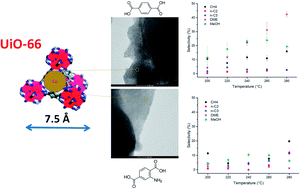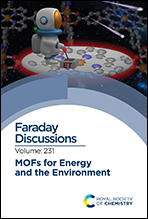Effect of linker functionalisation on the catalytic properties of Cu nanoclusters embedded in MOFs in direct CO and CO2 reduction by H2†
Abstract
Metal–organic frameworks are promising host supporting matrices for catalytically active guests. In particular, their crystallinity renders them desirable as their pores may act as atom-precise templates for the growth of nanoparticles or nanoclusters therein. This is very advantageous for studying the fundamentals of heterogeneous catalytic processes, especially for site-selective ones, in which the catalyst particle size and shape are of import. Furthermore, metal–organic frameworks may be decorated with organic functional groups, which affect a number of the frameworks’ physical and chemical properties, while remaining isotopological, i.e. having identical structural features and thus templating characteristics. Effectively, this allows for the independent tuning of the Brønsted and Lewis acidity of the substrate while the geometry of the catalytically active guest remains identical. In this study, we systematically study the effect of amino functionalisation of UiO-66(Zr) as a supporting matrix for Cu nanoclusters on the direct reduction of carbon dioxide with hydrogen. In particular, we have found that through modulation of the acidity of the inorganic nodes, framework functionalisation effectively controls the reaction selectivity.

- This article is part of the themed collection: MOFs for energy and environmental applications


 Please wait while we load your content...
Please wait while we load your content...